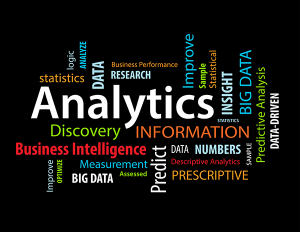 Depending on who you are speaking with, analytics means different things to different people. Listening to industry webinars and reading blogs about business intelligence and analytics, it’s clear that not everyone consistently distinguishes between different types of analytics – or even consistently acknowledges that there are different types.
Depending on who you are speaking with, analytics means different things to different people. Listening to industry webinars and reading blogs about business intelligence and analytics, it’s clear that not everyone consistently distinguishes between different types of analytics – or even consistently acknowledges that there are different types.
For most people Google Analytics is seen as the same thing as the analytics that business end users apply to make real-time decisions using current data and predicted trends.
In an effort to establish clarity for anyone working with data and business intelligence, here are four basic types of analytics:
- Descriptive – What happened?
- Diagnostic – Why did it happen?
- Predictive – What will happen?
- Prescriptive – What should I do?
The first two types of analytics require the most human input. Even predictive analytics needs a human interpretation for proper application. But for prescriptive analytics, often the prescription for success or change is mapped out with machine learning.
Descriptive Analytics
Most BI & analytics tools will provide descriptive analytics, though not all of them work in “real-time,” which makes them rooted completely in your data’s past. The amount of self-service and the level of integration with other systems and workflows can vary greatly. Many small businesses – and quite a few larger companies – make do with spreadsheets created by individuals to perform the simplest form of descriptive analytics.
Diagnostic Analytics
An analyst can use descriptive analytics to figure out what happened. But to figure out why it happened takes us into the realm of diagnostic analytics. By studying metrics of social media used in marketing products, it can be determined what Tweets or posts had the most response to generate the interest. If sales spike immediately after an email campaign was launched through the call to action used in that campaign, it’s apparent that the campaign contributed to the sales success.
Predictive Analytics
On the financial side, assessing credit risk would be an example of predictive analytics. By using past credit history and current finances, a financial institution (or a car dealership) can predict a customer’s ability and likelihood of paying off a loan. Sales and marketing can analyze customers on what they are likely to purchase and when they will make those purchases.
With predictive analytics, companies use past performance patterns to determine patterns and predict future outcomes and trends. The insurance industry leverages predictive analytics to determine appropriate rates including consumer credit information that despite being predictive is not without controversy. It doesn’t tell you what will happen, but by analyzing trends that have occurred it can help plan for anticipated patterns. Retailers use predictive analytics to determine when they expect consumers to start making purchases so they have a good idea when shelves need to be stocked.
Prescriptive Analytics
Prescriptive analytics can tell a worker what needs to be done to boost business outcomes. Directing the activities of people on the phone in contact centers to improve throughput or satisfaction is an example of this type of analytics. Prescriptive analytics is also valuable for workers who traditionally have to dig in and determine the appropriate action on their own, because it makes them more efficient. Ultimately, prescriptive analytics will lay out for users how to reach the desired outcome.
Gartner’s Alexander Linden said basic analytics provide a general summary of data, and advanced analytics deliver deeper data knowledge. Creating the optimal treatment plans for a patient can be prescribed through clinical diagnosis applications. Prescriptive analytics is applied across sources that include electronic health records data, drug information and study data.
Machine learning has also greatly enhanced the speed of predictive and prescriptive analytics and the breadth of data that can be incorporated. Machine learning can be seen in use when Pandora creates your ideal playlist by using your past habits, ratings, skipped songs and other data collected while you are listening to music. If you wondered how Amazon makes book suggestions, that’s another function of machine learning.

